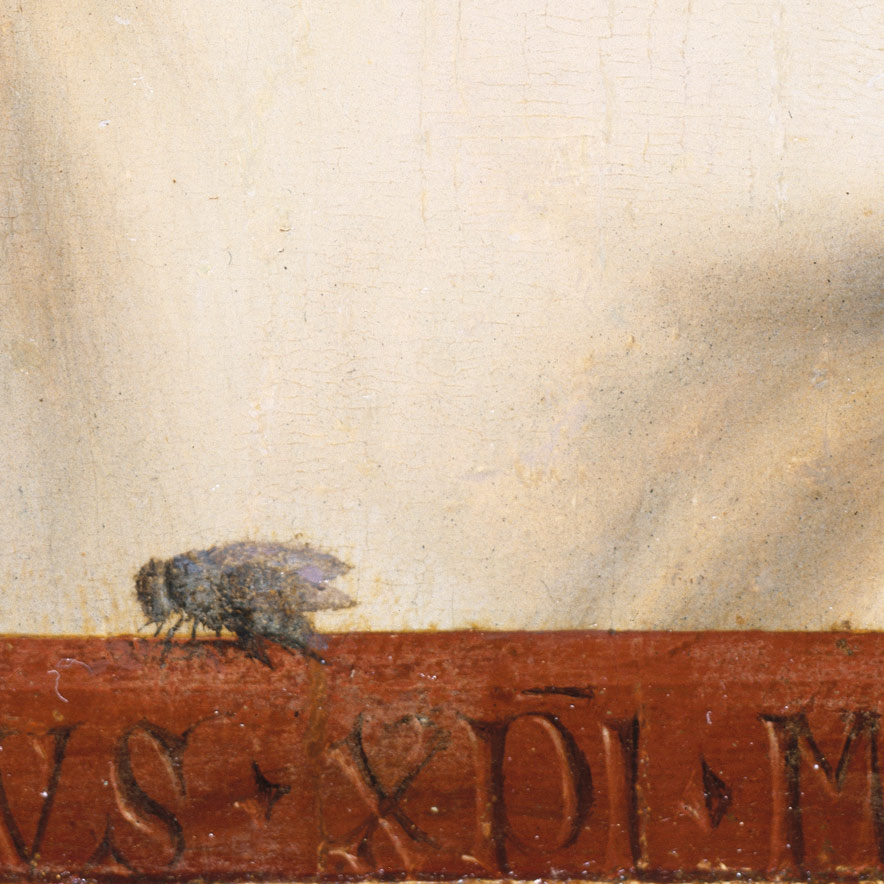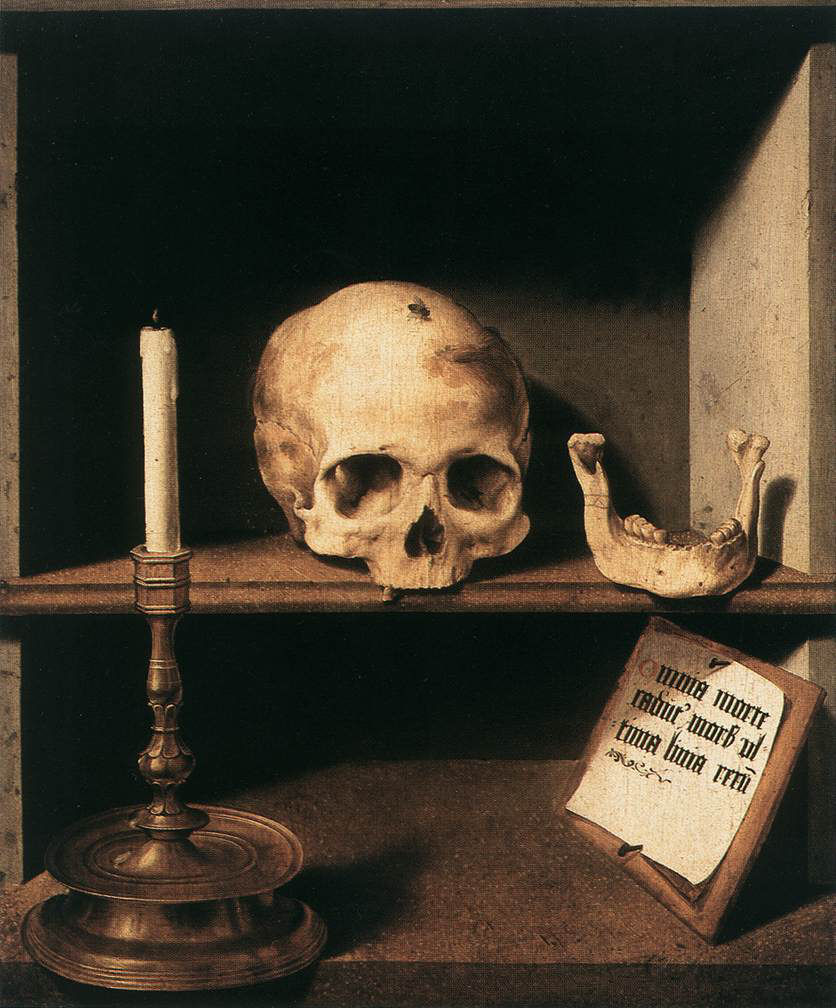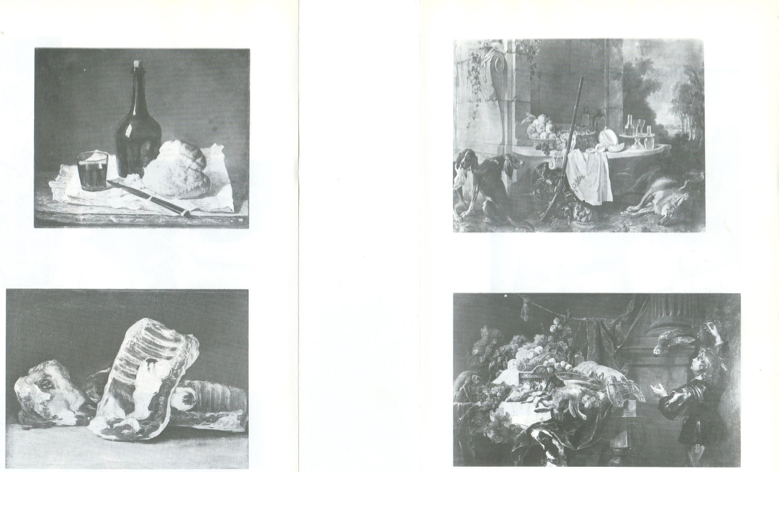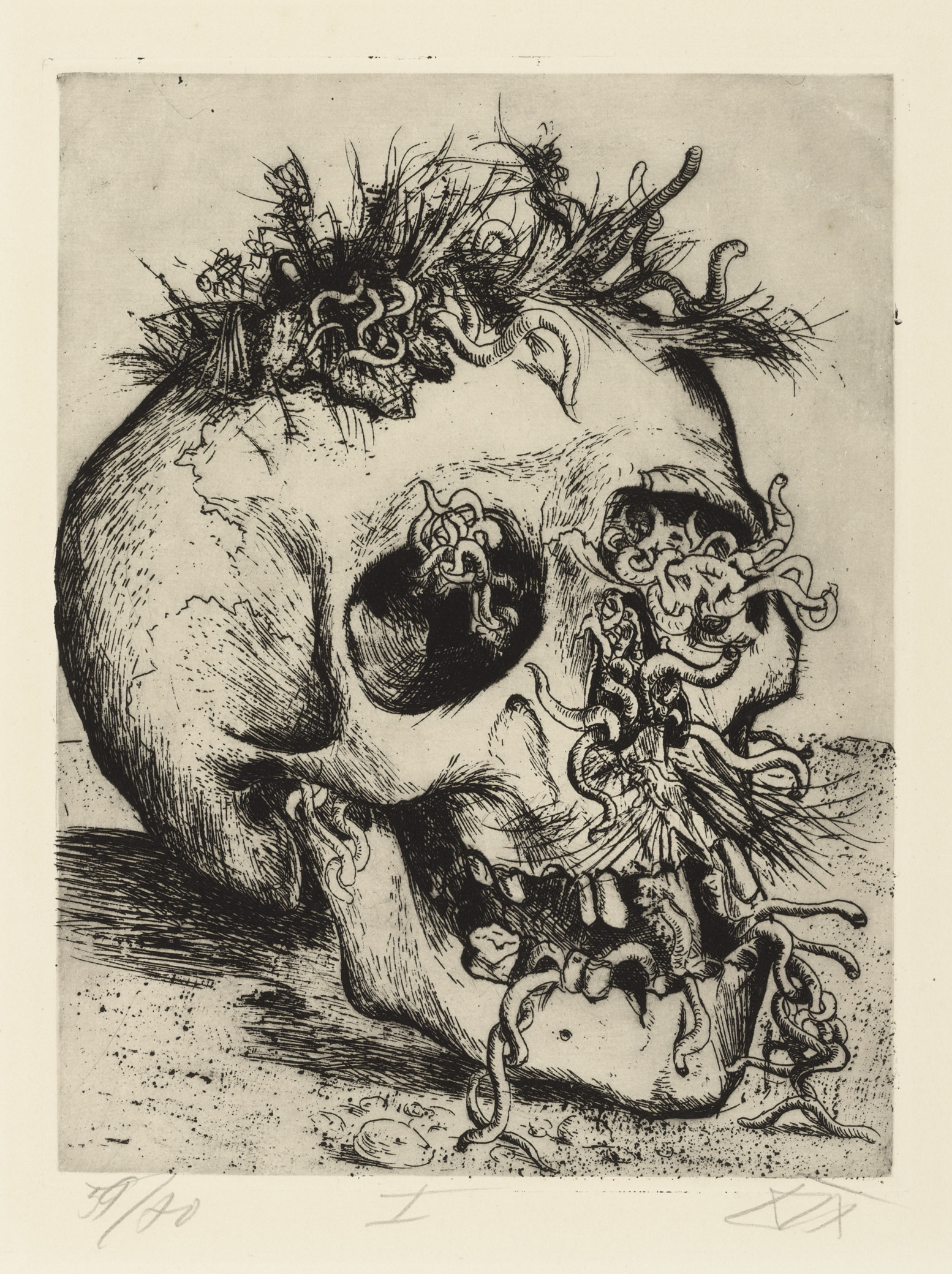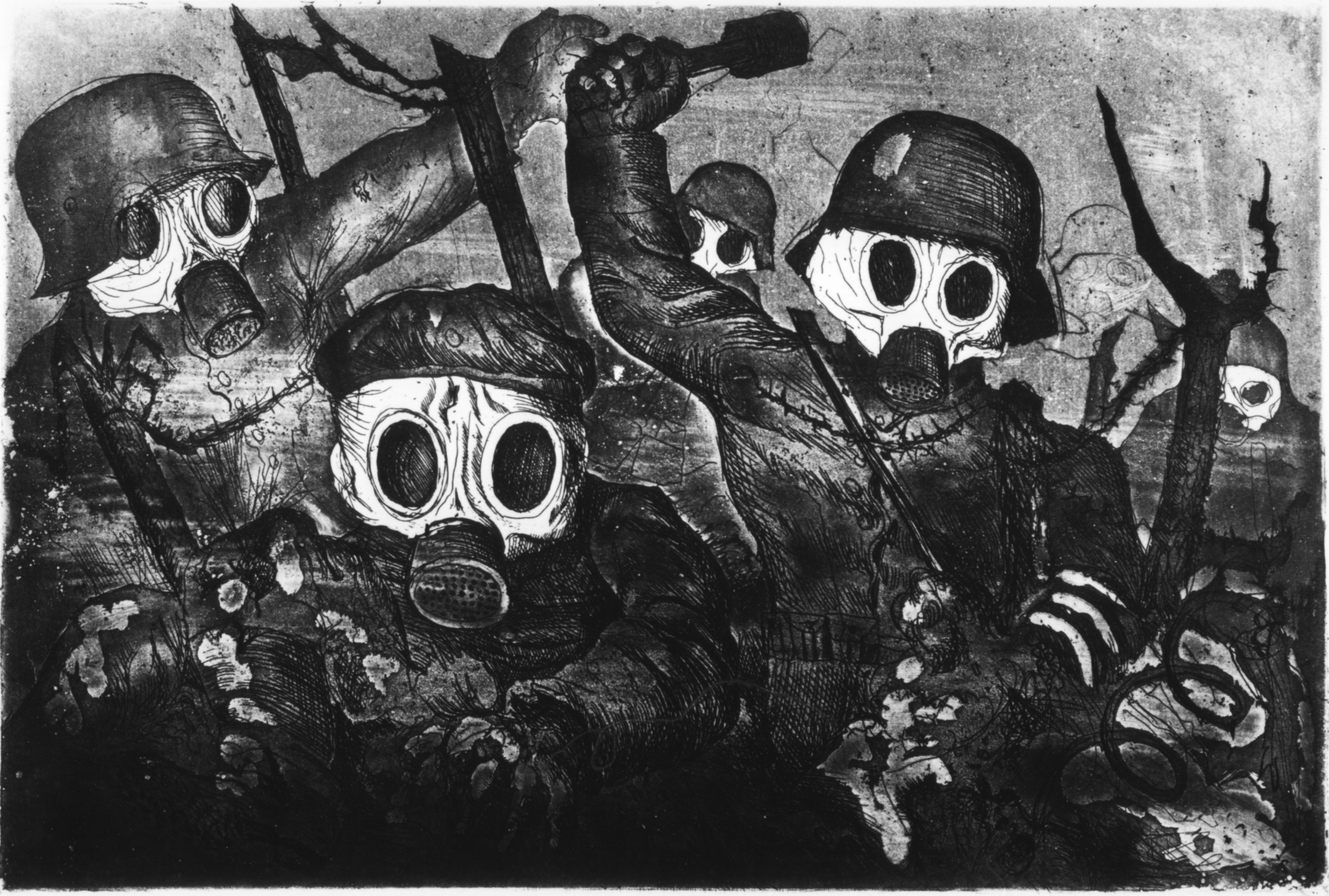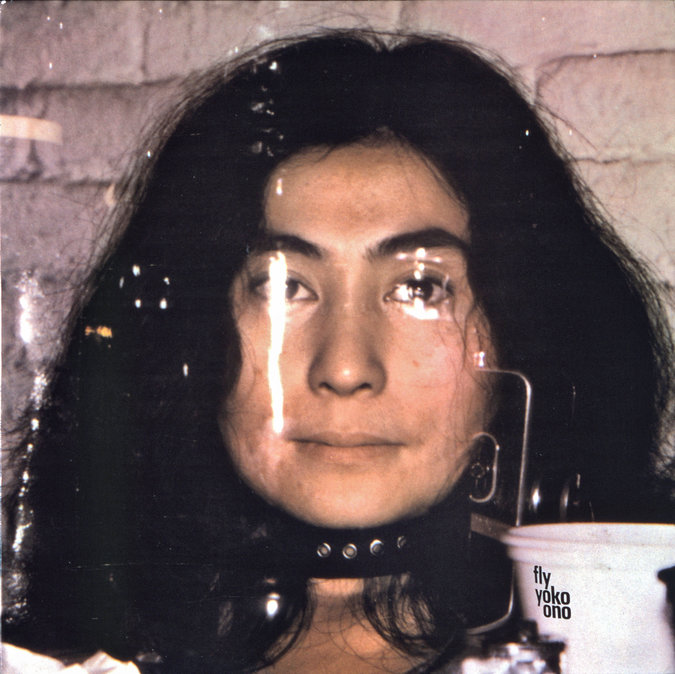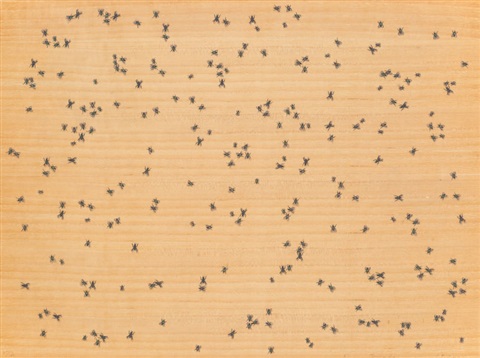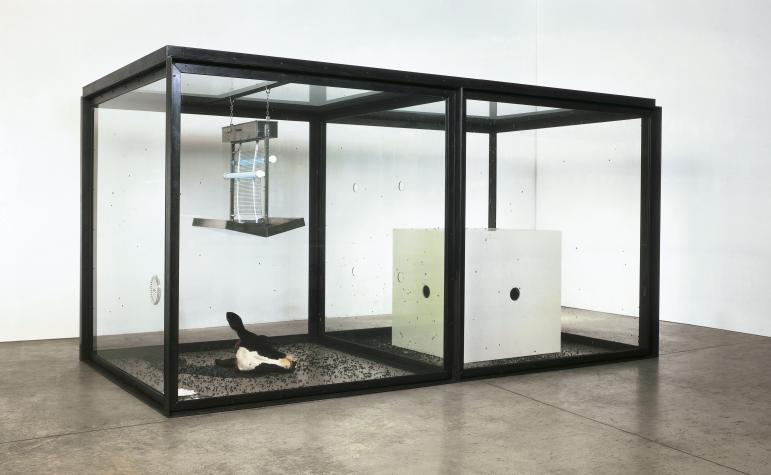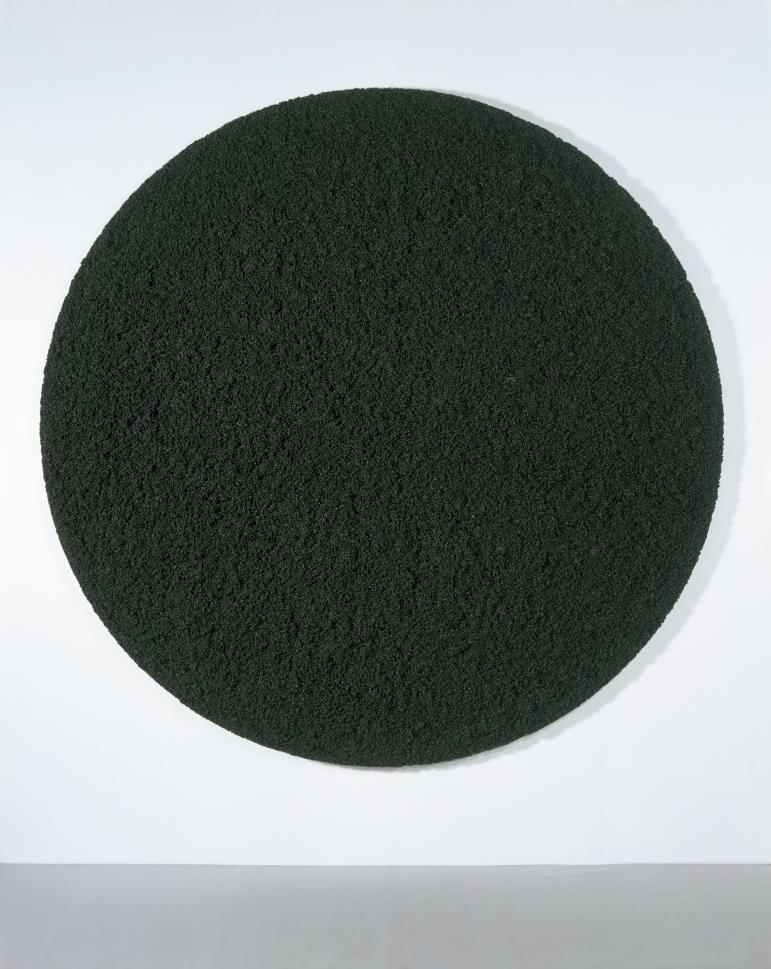The Fly, Pt. 1
In Gallery 641 of the Metropolitan Museum of Art hangs Portrait of a Carthusian, an oil-on-wood panel painting by Petrus Christus from the mid 15th century. Christus, who became the premiere painter of Bruges after the death of Jan van Eyck, was known for his innovations in linear perspective as well as a penchant for detail which scholars speculate was informed by illuminated manuscripts, and sure enough, both traits are on display in Portrait. The sitter, a Carthusian monk is depicted in three-quarters length bust view, facing slightly to the right but gazing straight ahead with steady eyes. He has a parted beard (rendered hair-by-hair it appears), characteristic bowl-haircut, white habit, and is seated before a deep red room. A light plays across the back wall from the upper left corner, but does not penetrate very far into his somber quarters.But even more than the depicted Carthusian himself, it is the frame that fascinates us—a dark wood all around, but at the bottom, it is broken with a lighter portion bearing the inscription “PETRVS·XPI·ME·FECIT·Ao·1446” (Petrus Christus made me in the year 1446). The inscription however, is a trompe l’oiel, painted in with the bottom of the frame to appear as a carving in the wood. It is a trick, employed often enough in portraiture of that period, and perceiving it, we may chuckle and move on, except that Christus baits us with a second illusion—sitting on the sill of the trompe l’oeil frame is a trompe l’oeil fly. At this addition, an insignificant portion of the surface of the painting, much less than a square inch, the whole pictorial space on the other side of the frame is thrown back. While the viewer may have been amused at the trick of the frame, the fly creates amuch more uneasy feeling, even a sense of vertigo. We realize that we are not observing a painting, but a communicant’s scene. The Carthusian is not on a panel, but in a booth, it is as if the latticework has dropped from the confessional and we suddenly see our priest face-to-face. Our sins are suddenly revealed to human ears when we spot that single vertiginous fly. The fly wields a terror.
The Fly, Pt. 2
Could it be that the fly has ears? What could it tell us of the rooms in which it has been hung, of the sitter and painter and patron and viewer? For the fly is certainly not a stranger to the world of painting. For centuries it has frequented the portraits and tables of history, but has it always been with a mission to cause unease? Before appearing in portraiture, the fly was a regular in illuminated manuscripts and books of hours, in forms both banal and fantastic. We must remember that in medieval times, before refrigeration and modern sanitation, the fly was a much more common part of life than the occasional annoyance we experience now. Yet they held a dark mystique, as did many other insects and amphibians, as it was commonly held that they spontaneously generated due to sunlight and decomposition. Aristotle himself had postulated that they arose independently of sexual reproduction, a concept which was taken up by the medieval church and used as an argument for the virgin birth, as found in the sermons of Psuedo-Augustine:“If God can produce men by means of sperm, then he can also produce them without it. For if the sun, by its own power can generate a frog or a fly, without the concurrence therein of any other frog or fly, but merely from mud or mire, by how much more may God, through his infinite power, produce a man without any concurrence of male semen, but solely through the pure blood of the Blessed Virgin.”
This belief would persist until Pasteur’s definitive 1859 experiment, but until then, a great many artists were laboring under that false assumption.
Still, the traditional interpretation of the fly has had more to do decay and mortality than autogenesis or revivification. The Netherlandish vanitas paintings frequently incorporate flies amidst decaying fruit, wilting flowers, or more explicitly, crawling on skulls posed with snuffed out candles, as in Barthel Bruyn the Elder’s Vanitas. But this is by no means the sole interpretation, art historian Felix Thülemann has proposed that the fly can also serve as a form of signature, a representation of painterly prowess, which perhaps is more in line with Christus’ trompe l’oeil fly, which appears near Christus' conspicuous signature. This is elaborated further in Steven Connor’s excellent essay Flysight, in which he traces the artistic lineage of the fly-as-signature, pointing out that in a 1609 portrait of Albrecht Dürer by Johann König (based on Dürer's self-portrait in Feast of the Rose Garlands) Dürer displays a document in which his signature is replaced by a fly. Connor also hints at the origins of the artist’s fascination with the fly, citing a legend of a realistic fly painted by Giotto which fooled his master Cimabue, an anecdote taken from Vasari’s Lives of the Painters.
We are, of course, indebted to John Berger for his observation that the still life is not just a moral illustration, it is also a depiction of wealthy lifestyle of its patrons. While he does not mention the fly explicitly in Ways of Seeing, he shows the European tradition through the lens of possession, and it is only a small step further to imagine that the artist would also flaunt some possession, in this case: skill. At a time when artist’s had relatively little say in subject matter, the fly was a stowaway with an abundance of meaning, a boast and a taunt at the wealth from which they were paid.
The fly, then, was an ally of the artist, a biological compatriot of one who was expected to make something from nothing (or from a blank canvas and assorted pigments, many of which came from insects themselves). We can then reevaluate the vertigo set in motion by the Carthusian’s fly—while death and decay cannot be denied, there is more to the cycle than just that—those elements are merely making way for the new, as of course those old painterly traditions will do in time. Perhaps, along with its terror and decay, the fly is also showing a way forward.
The Fly, Pt. 3
Post-Pasteur, the fly experienced a drop in popularity in the arts, in fact, the fly had been out of favor for at least a hundred years by the time of his experiment. Rococo was too gauzy an environment for the fly, Romanticism too idealized, Neo-classicism too dramatic, Impressionism too blurred and early photography not quick enough to capture its elusive frame. When it re-emerged, the fly was a very different creature. No longer subjected to misconceptions of spontaneous generation, it became both more scientific and more mutant.The fly now became a subject in itself, no longer just a symbol, signature or sideshow. Aside from visual art, Franz Kafka’s 1915 Metamorphosis tells the tale of Gregor Samsa awakes to find himself a giant insect. Although Kafka isn’t specific about the exact breed of insect (the charwoman calls it a “dung beetle” in most English translations), Metamorphosis sets a model for how the fly is depicted in the 20th century. No longer a static signifier to viewers, the fly becomes a horrific reflection. Samsa is awakened in his transformed state with thoughts of work foremost in his mind. His body has become foreign to him, but his primary concern is a business trip he must set out for early on the very morning of his misfortune. Language as well is lost. While he can understand his family’s speech, his own is rendered garbled bug noises. His condition is inexplicable, his fate is random and his universe somehow far less ordered than that of the Renaissance. The insect reemerges from its 100 year neglect as an alienated figure, a mutant in the modern world.
Here, the fly is enormous, all consuming, unlike the minute reminders of the past. The fly becomes capable and then incapable of labor, is isolated from the pleasures it once enjoyed, and ceases to be treated with any form of dignity. But as the fly becomes this “big other” its depiction in its recognizable scale has all but vanished. One expects to find flies in Otto Dix’s work, and they do if only scarcely—a single fly in the hair of Dix’s Schädel, and a few others scattered throughout his Der Krieg cycle. A contemporary of Kafka, Dix’s paintings and prints abound with destruction and corpses, prime targets for the flies we know from the decomposing still lifes. But they are rendered far from the trompe l’oeil we remember, drawn only with a few quick scratches. The most striking resemblance we find, is not in the hovering insects however, but in is his gas-masked soldiers, with enormous, round, fly-like eyes. They are Gregor Samsa-scale fly men, and unlike Samsa, they are far too good at their jobs.
The Fly, Pt. 4
Connor’s essay thoroughly documents Dali’s fascination with the fly, from its frequent appearances in his paintings and etchings, to his deliberate efforts to attract them to himself with date juice and anchovy oil. Dali was not the only Surrealist-related artist to dabble in flies however, though probably the most prolific (and least nuanced).In other Surrealist works, the fly comes to symbolize much the opposite of what it represented in older still lifes and portraiture. The fly is imbued with an excess of life, merged with other creatures in fantastical ways, or vigorously defying mathematics. Consider Leonora Carrington’s Fina Mosca (Delicate Fly), in which the fly becomes a mandala of assorted life forms. Encompassing bivalves, birds, insects, sea creatures, crocodiles, ostriches (?), humans and any number of mythical or fabricated beasts and heavenly bodies, the fly is a cosmos unto itself. It has also taken on human anatomy of its own, hands, feet and face, a glorified version of Kafka’s repulsive Samsa. The title recalls the first line of Breton’s Manifesto of Surrealism, “So strong is the belief in life, in what is most fragile in life – real life, I mean – that in the end this belief is lost.” Here, the fly embodies the aims of Surrealism, where the body and mind has been taken over by the forces of life, both interior and exterior, which society previously tried to fortify itself against. It is the delicate space the fly occupies—its slight scale and short lifespan and its dependency on death and decay—that makes the fly a worthy totem.
The fly is not a fixed symbol in Surrealism though. It undergoes a myriad of metamorphoses, from the grotesque in the work of Félix Labisse, to the elegance in Remedios Varo’s, to a frantic drawing tool at the hands of Max Ernst, to a near reduction to pure form in the photographs of Man Ray. The fly itself becomes an exquisite corpse game of the Surrealists, able to take on a variety of forms and endlessly mutate from one artist to the next—which coincidentally is the fly’s biological fate. Beginning from the egg (up to 150 laid at a time), hatching to a larvae (commonly called a maggot), pupating for three to six days (the Surrealist dream state?), and finally emerging for an adult life of 15–30 days, the flies life is varied and multiplicitous but short, all to soon appear again in another form.
The Fly, Pt. 5
Surrealism’s composites of the fly may be novel, but we have seen them before. Their precedent is in the pictures of Hieronymus Bosch, the visionary of symbolic biological conglomerations. Though there may be bits of the fly strewn throughout Bosch, the most recognizable ones I could find were in the left panel of his Haywain Triptych, a panel painting depicting the inhabitants of earth lasciviously dismantling a mountain of hay for their own purposes, all the while being dragged into hell and ignoring heaven above. Hay, an allegory for wealth in agrarian medieval society, is the focal point of the triptych, dominating the center panel, while in the periphery, the true scenes of consequence occur, a mirroring of the prevalence of greed in the world. The flies in the upper lefthand corner stream out of the reddening clouds above Eden, a scene of the expulsion of the demons from heaven just above that of Adam and Eve from the garden.The Fly, Pt. 6
Returning from our brief apocalyptic detour, we find ourselves pursuing the fly into the early 70s, where it again crops up in several notable artworks. In Yoko Ono’s 1970 film Fly, a single fly is released on a naked woman’s body, and the camera tracks it in close shots as it crawls and flies around different body parts, some barely recognizable due to the close crop and others the unmistakable anatomy of lips, a nipple or an ear. The soundtrack, by the way, is Yoko Ono’s piercing imitations of fly sounds, a track which would appear on her album of the same name.To put it context, Fly was made in the same year as Freedom, in which Ono is shown attempting to rip her bra in half but the film freezes and fades out before her success, and a year after Lennon and Ono’s Rape, a dialogue-less film with the camera essentially stalking a woman before she is knocked down in symbolic assault. Proceeding from these films, Fly becomes an indictment of the male gaze, and moreover, of the portrayal of women in art history. Here the fly has been made the star and the woman reduced to landscape. The painter’s symbolic signature and frequent model, the fly and the female body, finally meet in live action. In the final scene, the camera returns to find not just one but dozens of flies exploring the actresses body. Ono’s fly is not the liberating depiction of some of the Surrealists (Remedios Varo for example), it is the fly that must and will be shaken off or swatted, a militant version of Francis van der Myn, The Fly.
If the fly was the star in Ono’s work, then it becomes an extra in Ed Ruscha’s. His 1972 Insects portfolio picks up seamlessly from where Fly leaves off, with constellations of ants, cockroaches, and of course, flies amassed over wood (silkscreened on wood veneer) or other linoleum-like surfaces. There is nothing particularly distinct about any of Ruscha’s flies, in this he plays off Aristotle’s labeling of such spontaneously generating creatures as “nondescripts”. He employs the trompe l’oeil until it is absurd, obliterating its significance as an indexical mark, repeating the trick and thereby emptying it of meaning. This is the fly after Warhol, and one can imagine them resting on the same countertop with Campbell’s soup cans and Brillo boxes. This is the fly, the celebrity of art history, in an age where we have forgotten about its cyclical significance to death and decay and only see it as an annoyance.
The Fly, Pt. 7
Sometimes what is most remarkable about the fly is its absence. In some places where we expect to find it, we see none. For example, Francis Bacon’s Figure with Meat seems as if it would be a fly’s paradise, but none are to be found. The effect of their absence is something much more chilling, it is as if we have encountered this figure, a reworking of Velázquez’s Portrait of Innocent X, in cold storage. The nightmare is contained on a very personal level, one is always alone with the horror and not even the flies can sympathize.The Fly, Pt. 8
In Ludwig Wittgenstein’s Philisophical Investigations, remark #309, he asks and answers a question: “What is your aim in philosophy?—To shew the fly the way out of the fly-bottle.” Curiously, Wittgenstein’s analogy shows up in the midst of a discussion of pain, considering our language surrounding pain and the means by which we can convey our sensations to another. This remark seems somewhat out of place in the flow of the text, as if the analogy has suddenly occurred to Wittgenstein at that moment and he must write it down in order to remember the next time he is pressed with the question. He describes his philosophical project as one of extraction and revelation. He believes the traditional trajectory of philosophy has become unproductive and he wants to lift it to another form in which we can analyze thought from “outside the bottle”.So why does Wittgenstein insert the fly remark at this particular point in his reasoning? My best guess is because understanding another’s pain takes an effort to “other” oneself, to inhabit a new position, just as the act of studying philosophy demands that we introspect as if we were another investigating ourselves. The two processes are the inverse of each other, in one we are on the outside seeking to look out from an interior position, and in the other, we are on the inside seeking to look in from an exterior position. The fly itself is helpless within the bottle, its perspective too small and its resources too limited. There is a link here between pain, philosophy, art and death that is only a few steps more to draw.
Perhaps more to the point of our art historical investigation, a few pages earlier, in remark #301, Wittgenstein states “An image is not a picture, but a picture can correspond to it.”
The Fly, Pt. 9
I included an image of Damien Hirst’s A Thousand Years previously, but didn’t mention it in the text, partly because it’s an appropriate mute pairing for Wittgenstein’s fly-bottle, but also because it brings up a lot more than I had the capacity to deal with at the moment. Hirst’s oeuvre is one of the most polarizing in contemporary art, ranging from genius to incredibly lazy (and sometimes both at once). It’s often the example detractors of so-called modern art point to as revealing that the “emperor has no clothes”—the work is made on a factory scale, Hirst hardly (if ever) touches the final pieces, his use of readymades is sometimes difficult to justify, he was one of the most wildly speculated-upon artists of the YBA group (until he flooded the market)—and the list could go on. In Hirst’s work however, the fly becomes more meta than in that of any previous artist, and at his best, he represents an ultimate view of the fly, one that encompasses all uses before it.For Hirst, the fly is a medium, a calling card and a performer. Consider his A Thousand Years (a more elaborate reworking of his previous A Hundred Years), an early breakthrough piece in which he released thousands of flies into a glass enclosure containing a cow’s head, an “Insect-O-Cutor”, and dishes of various sugary treats. This is the cynical brilliance of Hirst at its best, he is setting in motion a self-contained ecosystem, harnessing life, death, pain and reward, all to be spectated in real time.
Hirst artworks are largely self-interpreting. His material and formal references to minimalism strip the viewing experience to the bones, fixing your attention on the main attractions. The debate surrounding them is more often over external validity than the merits of the work in its own closed system, and since everything exists in its most generic form, the pieces adhere as nearly to Platonic ideals as possible. This holds true for his use of flies in the Years works as well. Hirst uses the fly as a live performer, something we caught a glimpse of in Ono’s work, but only via film, never directly. He is taking advantage of their “programming”, in Michael Kirby’s terms, they are the ultimate nonmatrixed performers. In doing so, Hirst positions himself in a incredibly stacked lineage, from the Renaissance wizardry of Leonardo da Vinci (who Vasari recorded as creating spectacles by strapping scaled wings to exotic lizards), to Pasteur’s experiments disproving spontaneous generation, to a whole host of previously mentioned art historical references—the flies of vanitas, Bacon’s hanging meat (channeling Rembrandt, see also Hirst's The Tranquility of Solitude (for George Dyer)), and the black hordes of Dali, Ono and Ruscha just to name a few.
Most strikingly however, is his relationship to Wittgenstein’s statement, about his philosophical goal of showing the fly the way out of the bottle. Here, Hirst models that scheme in an almost one-to-one relationship, and one cannot help to think Hirst aspires to a similar task translated to the arts. Hirst’s titles often give him away, they are the most overwrought part of the work (save the diamond skulls). Who can forget classics like The Physical Impossibility of Death in the Mind of Someone Living or Some Comfort Gained from the Acceptance of the Inherent Lies in Everything? They expose his philosophical ambition, which is to show the art world itself from “outside the bottle” and for one so often dealing in glass partitions, that is the only analogy appropriate. Hirst wants to be the Wittgenstein of artists, a meta-artist dissecting the very structure of the game.
But this is also Hirst’s undoing. The counterpoint to the Years works is his series Fly Paintings, disgusting masses of fly carcasses glued or resined to rectangular, round or star-shaped canvases. Not only are the fly paintings some of his most lazy works, the titles are heavy-handed and too loaded for them to bear (in his 2004 retrospective at Museo Archeologico Nazionale, Naples, four appeared with the titles Typhoid, AIDS, Genocide and Holocaust. Hirst’s four horsemen reference doesn’t go unnoticed, but his conceptual weak point is exposed—the oversimplification of death and disease comes off as trite and distasteful. Looking at them, one is reminded that Ad Reinhardt called his black-on-black paintings “the last paintings anyone can paint”, and similarly, Hirst’s fly series feels like the literal and figurative death knell of the fly in art.


